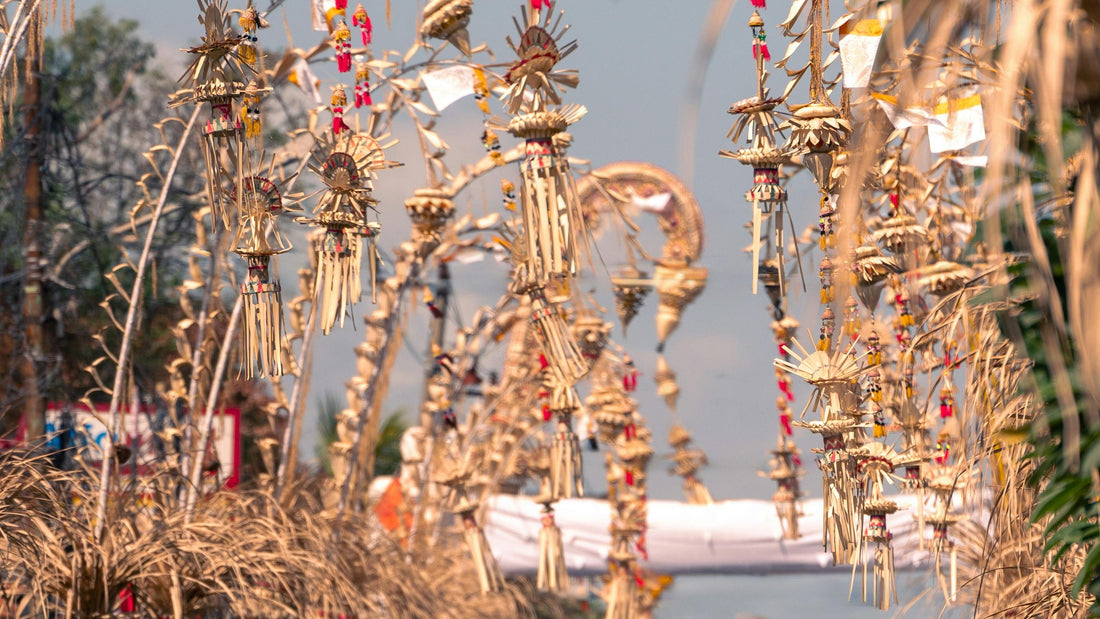
Galungan and Kuningan in Bali 2025: A Local’s Complete Guide to Bali’s Most Spiritual Celebrations
Andy WilliamsIf you’ve ever wandered through Bali’s villages and seen the roads lined with beautifully curved penjor—those tall bamboo poles decorated with coconut leaves, flowers, and offerings—chances are, you’ve been here during Galungan and Kuningan. As a Balinese, this is the most sacred and meaningful time of the year for our family—and for every household across the island.
These are not just religious holidays, but deeply spiritual occasions when we believe the spirits of our ancestors return to Earth to visit us. It’s a time for ritual, reflection, family, and honouring those who came before us.
If you’re familiar with Día de los Muertos in Mexico, you’ll immediately notice some beautiful similarities. Just like in Mexico, we invite our ancestors back home with offerings, prayers, and food. The main difference? Ours is much quieter. There are no mariachi bands or sugar skulls—just deep devotion, soft chanting in temples, and the rustling of ceremonial garments.
Whether you’re a cultural traveller, a spiritual seeker, or just curious about life beyond the guidebooks, here’s everything you need to know about Galungan and Kuningan 2025 in Bali—including practical tips, rituals, and global parallels.
Galungan & Kuningan Dates in 2025
Because Balinese follow a 210-day Pawukon calendar, Galungan and Kuningan occur twice in 2025:
-
First Cycle:
- Galungan – Wednesday, April 23, 2025
- Kuningan – Saturday, May 3, 2025
-
Second Cycle:
- Galungan – Wednesday, November 19, 2025
- Kuningan – Saturday, November 29, 2025
If you're looking to experience rich traditions in a serene setting, April offers perfect weather with fewer crowds—ideal for slow cultural exploration.
What Is Galungan All About?
Galungan celebrates the victory of Dharma (good) over Adharma (evil). But more than that, it marks the time when ancestral spirits are believed to descend from the heavens to bless us and spend time among their families.
We welcome them by cleaning our homes, creating offerings, and visiting temples—usually wearing our best white ceremonial clothing. It's a powerful reminder that we’re part of something bigger than ourselves.
🌎 Similar to...
Galungan has beautiful parallels to:
- Día de los Muertos (Mexico): Both honour the return of ancestors. But where Día de los Muertos is colourful, loud, and full of life, Galungan is quiet, prayerful, and introspective.
- Obon (Japan): Another ancestral festival where families light lanterns and return to hometowns to remember those who’ve passed.
- All Saints’ Day (Europe): Particularly in Catholic countries, families visit cemeteries, light candles, and offer flowers—echoing our visits to temple shrines and home altars.
And What About Kuningan?
Kuningan takes place 10 days after Galungan, marking the day when ancestral spirits return to the heavens. The name "Kuningan" comes from “kuning,” meaning yellow, and the color symbolizes purity and blessings. We make yellow rice offerings (nasi kuning), and the atmosphere is more contemplative—like saying farewell after a long-awaited reunion.
Unlike Galungan, Kuningan ceremonies are completed before noon, and the island returns to a peaceful, reflective state for the rest of the day.
Pre-Galungan Rituals (What to Watch For)
The lead-up to Galungan is just as important as the day itself. If you’re already in Bali a few days before, here’s what to look out for:
3 Days Before: Penyekeban
Families begin preparing food—especially ripening bananas—to be used in offerings.
2 Days Before: Penyajaan
Homes smell sweet with the aroma of jaja (traditional cakes) being made for offerings.
1 Day Before: Penampahan
This is the busiest day. You’ll hear sounds of cooking, see penjor being erected in front of homes, and watch the island transform into a sacred, decorative wonderland.
What to Expect on Galungan Day
On Galungan morning, the island awakens to a sacred rhythm:
- Families dress in full traditional attire.
- Offerings are brought to family temples and community shrines.
- Villages come alive with temple visits, gamelan music, and the smell of incense and flowers.
Personal Tip:
Wake up early and take a walk through a village like Sidemen, Pengosekan, or Pejeng. You’ll witness quiet ceremonies and beautifully dressed families heading to temple—it’s Bali at its most beautiful and most sincere.
What to Eat During Galungan & Kuningan
If you’re lucky enough to be invited to a Balinese home or guesthouse celebration, here are the dishes to look forward to:
- Babi Guling (roast pork) – cooked over an open flame and infused with lemongrass and turmeric.
- Lawar – a mix of vegetables, coconut, and minced meat or jackfruit.
- Sate Lilit – skewered minced fish or chicken.
- Jaja Bali – colourful traditional cakes offered to both gods and guests.
And for Kuningan, expect nasi kuning (yellow rice) served with egg, chicken, and fried tempeh.
Traveller Tip:
On Kuningan morning, try ordering nasi kuning from a local warung in Ubud or Gianyar. It’s made with love—and a perfect way to taste the spirit of the celebration.
Penjor: Bali’s Living Symbols of Gratitude
You’ll see penjor rising along every street, especially in traditional villages. They are tall bamboo poles, gracefully arched, and decorated with coconut leaves, fruits, and sacred items.
They symbolize Mount Agung, prosperity, and our offerings to the divine.
Photo Spots for Penjor:
- Jl. Kajeng, Ubud
- Jl. Danau Tamblingan, Sanur
- Villages around Tabanan or Bangli
Experiencing These Festivals Respectfully as a Visitor
-
Dress Appropriately
Bring or rent a sarong and sash—required at temples and respectful even outside ceremonies. -
Keep a Low Profile
These are family and community holidays, not tourist performances. Observe respectfully and avoid disrupting ceremonies. -
Ask Before Taking Photos
Especially inside temples or during rituals. Most locals are happy to share if asked kindly. -
Don’t Expect Business As Usual
Some shops or restaurants will close early or entirely on Galungan and Kuningan days. Plan meals and transport in advance.
Where to Stay During Galungan & Kuningan
For a deeper experience, I recommend:
- Ubud: Spiritual heart of Bali, filled with ceremonies and community events.
- Sidemen: A quiet village surrounded by rice terraces—ideal for slow, reflective travel.
- Canggu or Seminyak: If you prefer modern comforts while still catching glimpses of tradition.
Look for accommodations that:
- Are run by local families
- Offer cultural experiences or temple visits
- Provide traditional meals during the holidays
Final Thoughts: Why These Festivals Are Worth Experiencing
If Nyepi is about silence and stillness, then Galungan and Kuningan are about gratitude, legacy, and connection. They are deeply woven into our identity as Balinese, and I truly believe visiting during these dates offers one of the most authentic insights into Balinese life.
It’s not flashy or touristy—it’s sacred, heartfelt, and deeply human.
So come with open eyes, open ears, and an open heart. Watch quietly. Listen carefully. You’ll walk away with more than just memories—you’ll leave with a better understanding of what it means to be connected to land, to spirit, and to one another.
Planning Your Visit?
Head to GrazieBali.com to book floating breakfasts, flower pool decorations, or even create your own personal experience at villa during Galungan or Kuningan. We’re locals here—ready to help you celebrate life beautifully and meaningfully in Bali.
